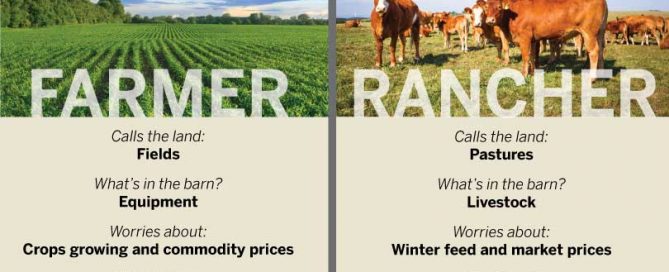Have you ever wondered what sets a ranch apart from a farm? You’re not alone.
These terms are often used interchangeably, but they actually refer to different types of agricultural operations. Understanding the distinction can open up a new perspective on agriculture and help you make more informed choices, whether you’re buying land, starting a business, or just curious about rural life.
Picture yourself standing on a vast open field, the sun warming your face, surrounded by the quiet hum of nature. Now, imagine trying to decide: Is this a ranch or a farm? Knowing the difference can enhance your appreciation for the land and its possibilities. Dive into this article, and you’ll discover not just definitions, but the unique characteristics that make ranches and farms special in their own right. Don’t miss out on the chance to deepen your understanding and perhaps even change the way you see the world around you.

Definitions
Understanding the difference between ranches and farms begins with their definitions. These terms often get mixed up, yet they represent distinct types of land use. Both serve unique purposes and operate differently. Let’s explore what sets them apart.
What Is A Farm?
A farm is land dedicated to growing crops or raising animals. Farmers focus on agriculture, producing food, fiber, or other goods. Farms can be large or small, depending on their production scale. They may include fields, barns, and greenhouses.
What Is A Ranch?
A ranch primarily raises livestock, such as cattle or sheep. Ranchers manage vast lands, often in rural areas. The landscape includes pastures and grazing fields. Ranches may also have facilities for livestock management.
Key Differences In Purpose
Farms aim to cultivate crops and animal products for consumption. They often use machinery and advanced techniques. Ranches, on the other hand, focus on breeding and raising animals. They rely on natural grazing for livestock.
Land Use And Management
Farms utilize land for planting crops or housing animals. They might rotate crops or use irrigation systems. Ranches manage large tracts for grazing. They ensure livestock have enough space and resources.
Types Of Products
Farms produce fruits, vegetables, grains, and dairy. They may also provide meat from animals raised for consumption. Ranches specialize in producing beef, lamb, and wool. They focus on high-quality livestock products.
Primary Purpose
The primary purpose of ranches and farms might seem similar to an outsider, but they cater to different needs. Understanding these differences can help you appreciate the unique roles each plays in agriculture and food production. Have you ever wondered why we need both? Let’s dive into their distinct purposes.
Cattle Raising On Ranches
Ranches are primarily focused on raising cattle. Picture vast open lands where cattle roam freely, grazing and growing. This setup allows ranchers to focus on breeding and maintaining livestock health. It’s not just about numbers but quality too. Ranchers often share a deep connection with their cattle, ensuring they thrive in their natural habitat.
You might even find ranchers discussing individual cattle as if they were family. This relationship is key to successful ranching. It’s a world where the cattle come first, and ranchers dedicate their lives to managing herds efficiently. Have you ever thought about the level of commitment it takes to manage a ranch?
Crop Production On Farms
Farms, on the other hand, are all about crop production. Rows upon rows of plants, carefully tended to, fill the landscape. Farmers focus on maximizing yield and quality. They strategize on crop rotation, pest control, and soil health. This is a life of constant planning and adjustment.
While visiting a farm, you might notice the meticulous care given to each plant. Farmers often experiment with different seeds or techniques to improve output. It’s not just about growing food; it’s about innovation and sustainability. Have you ever considered the impact of each decision a farmer makes on your dinner plate?
Understanding these purposes helps you appreciate the dedication and expertise involved in both ranching and farming. Whether it’s cattle or crops, each plays a crucial role in feeding the world. As you think about the food on your table, consider the passion behind its production. Which aspect resonates more with you?
Typical Activities
Understanding the daily activities of a ranch and a farm can clarify their differences. These activities often reflect their unique purposes and operations. While both may involve animals and plants, their focus and methods differ significantly. Let’s explore these typical activities to see what sets them apart.
Livestock Management On Ranches
Ranches primarily focus on raising animals. Cattle, sheep, and horses are common. Ranchers manage large herds across vast lands. They ensure animals have food and water. Herd health is a priority. Regular checks and vaccinations are routine tasks. Branding and tagging help identify livestock. Ranchers often use horses or ATVs to move herds. Grazing management is essential to maintain grasslands. Ranchers rotate pastures to prevent overgrazing. This ensures sustainable land use.
Cultivation Practices On Farms
Farms concentrate on growing crops. They involve planting, tending, and harvesting. Farmers prepare soil for planting using plows and tractors. Crop selection depends on climate and soil type. Irrigation systems provide water to fields. Fertilizers and pesticides enhance growth and protect plants. Regular monitoring helps detect pests and diseases early. Harvesting involves gathering ripe crops efficiently. Storage is vital to preserve produce quality. Some farms may also include small-scale livestock care.

Land Use
Ranches focus on raising animals like cattle or horses, while farms grow crops and may also have animals. Both use land for agriculture, but ranches typically have larger areas for grazing. Farms can include a mix of activities, emphasizing crops alongside livestock.
Understanding the way land is used can highlight the core differences between a ranch and a farm. While both involve working with the land, their focus and methods can be quite distinct. Land use is the key to distinguishing between these two agricultural settings. Whether you’re standing on a sprawling ranch or a diverse farm, you can feel the difference beneath your feet. Let’s dig deeper into how land use varies in these environments and how it impacts the work done there.
Expansive Land For Ranching
Ranches are often associated with vast, open spaces. Imagine standing on a wide stretch of land where the horizon seems endless. This is typical for ranches, where large areas are necessary to support livestock.
The primary purpose of ranch land is grazing. Cattle, sheep, or other livestock roam freely, feeding on natural grasses. If you’ve ever visited a ranch, you might have noticed fewer buildings and more natural landscapes.
Ranchers need extensive land to ensure their animals have enough space to graze and move around. The health and well-being of livestock depend heavily on the quality and quantity of grazing land.
Diverse Land For Farming
Farms, on the other hand, utilize land in a more varied way. Picture a patchwork quilt of fields, each growing different crops or housing various animals. This diversity is the hallmark of a farm’s land use.
Farming involves growing crops and raising animals, often in a smaller area compared to ranching. You might find fields of corn, rows of vegetables, or orchards filled with fruit trees on a farm.
Farmers focus on maximizing their land’s potential by rotating crops and employing sustainable practices. The goal is to produce a variety of goods, from grains to dairy, ensuring a steady supply of fresh produce.
Think about the last time you visited a farm—did you notice the variety of activities happening all at once? That’s the beauty of farm land use, where every inch is optimized for productivity.
Land use in ranching and farming reflects their distinct purposes and approaches. As you consider these differences, ask yourself: How does the land around you shape the work you do? Understanding land use can transform your perspective on these vital agricultural practices.
Geographical Distribution
Understanding the geographical distribution of ranches and farms helps in grasping their core differences. Ranches often thrive in arid regions, while farms flourish in fertile areas. This distinction is crucial for their respective operations and sustainability.
Ranches In Arid Regions
Ranches are typically found in dry, open landscapes. These regions have sparse vegetation and limited water resources. Ranchers often raise livestock such as cattle and sheep. Livestock grazing is suitable for these areas due to the vast open spaces. The arid climate poses challenges, but livestock adapts well. Ranchers often use extensive land management practices. These practices aim to preserve the delicate ecosystem. This environment supports hardy animals that can withstand harsh conditions.
Farms In Fertile Areas
Farms thrive in regions with rich, fertile soil. These areas support diverse crop cultivation. Farmers grow grains, fruits, and vegetables in these fertile lands. Ample rainfall and moderate climate benefit these regions. Fertile areas allow farmers to practice intensive agriculture. Farmers often use modern techniques to increase yield. Rich soil and favorable climate attract various farming activities. Crop diversity in these areas provides economic stability. Farmers can adapt to changing market demands with ease.
Economic Impact
The economic impact of ranches and farms is significant. Both contribute to the economy in different ways. Understanding these contributions can highlight their importance in our daily lives. Let’s explore how ranching and farming boost the economy.
Ranching Contributions
Ranches play a vital role in the livestock industry. They provide beef, pork, and other meats. This supports the meat processing industry. Ranches also create jobs. From cowhands to veterinarians, they employ many people. They contribute to the local economy. Buying supplies and equipment boosts local businesses. Ranchers also pay taxes. These taxes support community services and infrastructure.
Farming Contributions
Farms provide essential crops like wheat, corn, and vegetables. These crops are staples in our diet. They support the food manufacturing industry. Farming also creates numerous jobs. From planting to harvesting, many hands are needed. Farms help sustain rural communities. They purchase seeds, fertilizers, and machinery locally. This spending supports other businesses. Like ranches, farms pay taxes. These taxes help maintain schools and roads.
Cultural Significance
The cultural significance of ranches and farms varies greatly. Both hold a unique place in society. Each represents distinct lifestyles and communities. Understanding these differences enriches our appreciation of rural life.
Ranch Lifestyle
Ranches are often linked with cowboy culture. They showcase rugged independence. Ranchers prioritize livestock care and land management. This lifestyle is about wide-open spaces. It’s about living close to nature. Daily tasks revolve around cattle and horses. Ranchers value hard work and self-reliance. Their lives are shaped by the rhythms of the land. Traditions often include rodeos and cattle drives. These events celebrate ranching heritage. Ranch life fosters a strong connection to history. People cherish storytelling and passing down skills.
Farm Community
Farms focus on cultivating crops and plants. They thrive on community support. Farming involves collaboration among families and neighbors. Strong bonds form in these communities. Shared activities and local fairs strengthen ties. Farms often contribute to local economies. They provide essential food resources. Farming requires teamwork and shared knowledge. Community events celebrate harvests and achievements. Families pass down traditions through generations. Farm life emphasizes cooperation and mutual aid. The farm community values sustainability and resourcefulness.

Challenges Faced
Ranches focus on raising livestock, while farms grow crops. Managing animals on vast ranch lands presents unique challenges. Farmers deal with unpredictable weather affecting crop yields.
Ranches and farms are integral parts of the agricultural landscape, each with their unique challenges. Understanding these differences is crucial for those interested in rural life or considering a venture into agriculture. But what hurdles do they face? The challenges vary from environmental issues to sustainability concerns, each demanding attention and action.
Environmental Issues For Ranches
Ranches often deal with the impact of livestock on the land. Cattle and sheep can cause soil erosion if grazing is not managed properly.
You might have seen barren patches in fields where animals have grazed excessively. This isn’t just an eyesore; it leads to loss of nutrients in the soil.
Water usage is another significant issue. Ranches require substantial amounts of water for livestock, which can strain local water sources. You might wonder if there’s a balance between maintaining livestock health and conserving water.
Sustainability Concerns For Farms
Farms face their own set of sustainability challenges. Crop rotation and soil fertility are constant concerns.
Ever tried planting the same crop year after year? It drains the soil of vital nutrients, making it harder to grow healthy produce.
Pesticide use is another pressing issue. While they help protect crops from pests, they can harm beneficial insects and pollute the environment.
As a consumer, would you choose organic produce knowing it supports better farming practices? Farms must navigate these choices to ensure long-term sustainability.
Addressing these challenges requires innovative solutions and community support. As someone interested in agriculture, how would you tackle these issues in your own venture?
Frequently Asked Questions
What Defines A Ranch?
A ranch primarily focuses on raising livestock, such as cattle or sheep. It covers vast lands suitable for grazing. Unlike farms, ranches may not engage in crop production. The main purpose is animal husbandry, providing space for animals to roam and graze freely.
How Does A Farm Differ From A Ranch?
Farms mainly focus on growing crops or produce. They can also raise animals, but the primary goal is agriculture. Farms are smaller than ranches and use intensive methods. They aim for high yield per acre, emphasizing crop production over livestock.
Why Are Ranches Larger Than Farms?
Ranches require extensive land for grazing livestock. Animals need space to roam and feed naturally. This necessitates larger areas compared to crop-focused farms. The vastness ensures sustainable livestock management and healthy grazing practices.
Can A Farm Become A Ranch?
Yes, if a farm shifts focus to livestock raising. This involves reducing crop production and expanding grazing areas. Transitioning to a ranch requires changes in land use and management. The goal is to prioritize animal husbandry over agriculture.
Conclusion
Ranches and farms both play vital roles in agriculture. Ranches mainly focus on livestock. Farms grow crops and sometimes raise animals too. Both require hard work and dedication. Their goals differ, but each supports the food supply. Understanding their differences helps in appreciating their contributions.
Ranches offer wide, open spaces. Farms often have diverse fields. Each has unique challenges and rewards. Both are essential for feeding communities. Knowing these distinctions can deepen respect for their roles. Agriculture needs both for a balanced ecosystem. So, next time you see one, remember their importance.

I’m someone who’s always been fascinated by how small differences can lead to big understanding. That’s why I love writing “What’s the difference between…” content; it helps me explore topics from multiple angles and explain them in a clear, practical way. Whether it’s tech, productivity, business, or everyday decisions, I enjoy making complex ideas easier to compare, understand, and act on.










